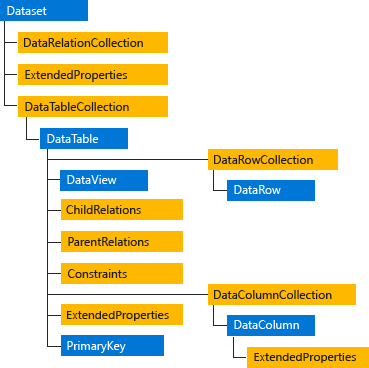Training
Module
Describe concepts of relational data - Training
This content is a part of Describe concepts of relational data.
This browser is no longer supported.
Upgrade to Microsoft Edge to take advantage of the latest features, security updates, and technical support.
The DataSet object is central to supporting disconnected, distributed data scenarios with ADO.NET. The DataSet is a memory-resident representation of data that provides a consistent relational programming model regardless of the data source. It can be used with multiple and differing data sources, with XML data, or to manage data local to the application. The DataSet represents a complete set of data, including related tables, constraints, and relationships among the tables. The following illustration shows the DataSet object model.

DataSet Object Model
The methods and objects in a DataSet are consistent with those in the relational database model.
The DataSet can also persist and reload its contents as XML, and its schema as XML schema definition language (XSD) schema. For more information, see Using XML in a DataSet.
An ADO.NET DataSet contains a collection of zero or more tables represented by DataTable objects. The DataTableCollection contains all the DataTable objects in a DataSet.
A DataTable is defined in the System.Data namespace and represents a single table of memory-resident data. It contains a collection of columns represented by a DataColumnCollection, and constraints represented by a ConstraintCollection, which together define the schema of the table. A DataTable also contains a collection of rows represented by the DataRowCollection, which contains the data in the table. Along with its current state, a DataRow retains both its current and original versions to identify changes to the values stored in the row.
A DataView enables you to create different views of the data stored in a DataTable, a capability that is often used in data-binding applications. Using a DataView, you can expose the data in a table with different sort orders, and you can filter the data by row state or based on a filter expression. For more information, see DataViews.
A DataSet contains relationships in its DataRelationCollection object. A relationship, represented by the DataRelation object, associates rows in one DataTable with rows in another DataTable. A relationship is analogous to a join path that might exist between primary and foreign key columns in a relational database. A DataRelation identifies matching columns in two tables of a DataSet.
Relationships enable navigation from one table to another in a DataSet. The essential elements of a DataRelation are the name of the relationship, the name of the tables being related, and the related columns in each table. Relationships can be built with more than one column per table by specifying an array of DataColumn objects as the key columns. When you add a relationship to the DataRelationCollection, you can optionally add a UniqueKeyConstraint and a ForeignKeyConstraint to enforce integrity constraints when changes are made to related column values.
For more information, see Adding DataRelations.
You can fill a DataSet from an XML stream or document. You can use the XML stream or document to supply to the DataSet either data, schema information, or both. The information supplied from the XML stream or document can be combined with existing data or schema information already present in the DataSet. For more information, see Using XML in a DataSet.
The DataSet, DataTable, and DataColumn all have an ExtendedProperties property. ExtendedProperties is a PropertyCollection where you can place custom information, such as the SELECT statement that was used to generate the result set, or the time when the data was generated. The ExtendedProperties collection is persisted with the schema information for the DataSet.
LINQ to DataSet provides language-integrated querying capabilities for disconnected data stored in a DataSet. LINQ to DataSet uses standard LINQ syntax and provides compile-time syntax checking, static typing, and IntelliSense support when you are using the Visual Studio IDE.
For more information, see LINQ to DataSet.
Training
Module
Describe concepts of relational data - Training
This content is a part of Describe concepts of relational data.